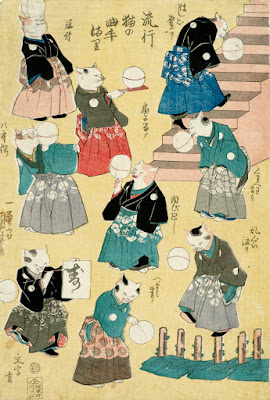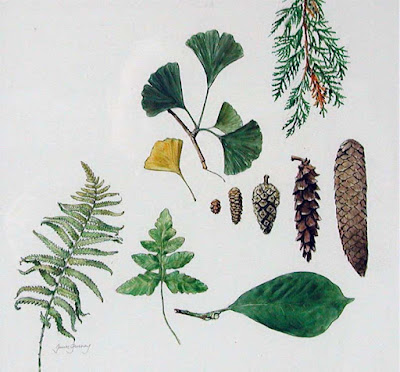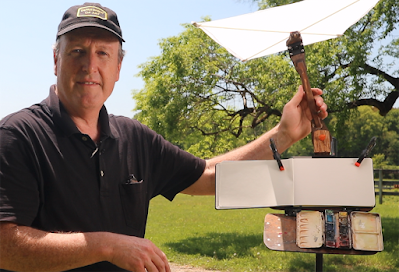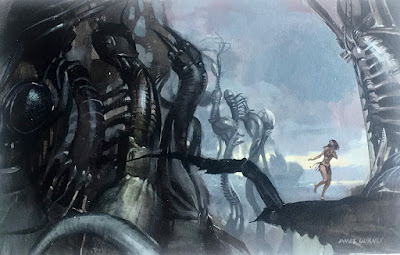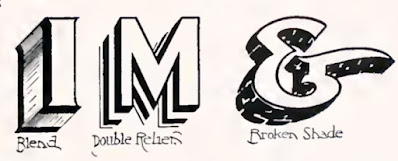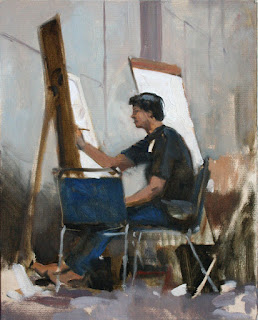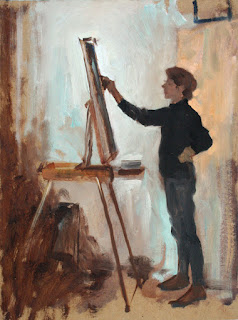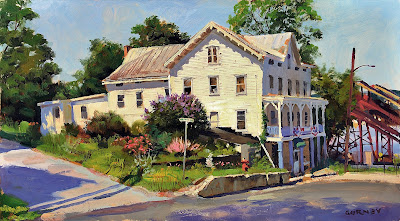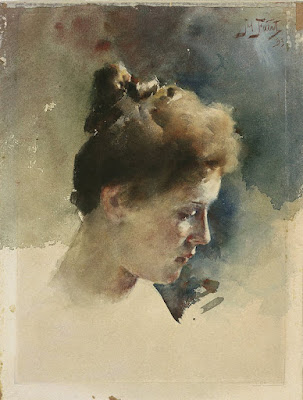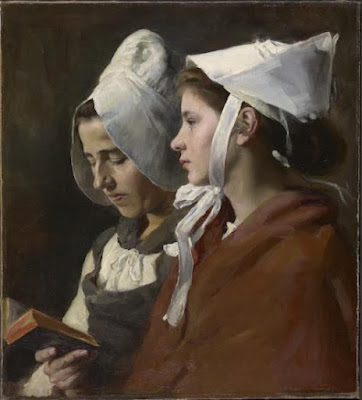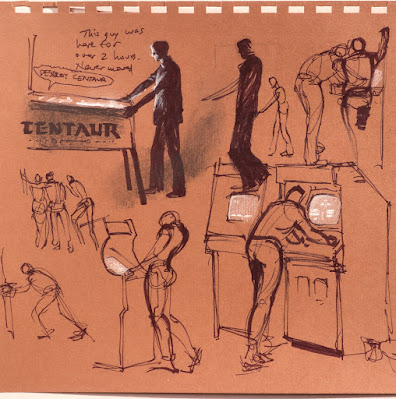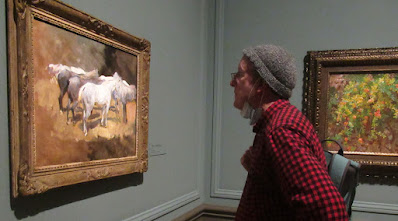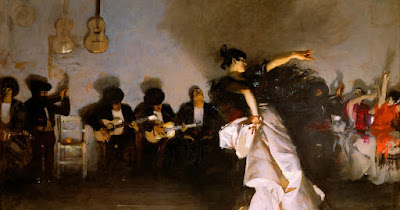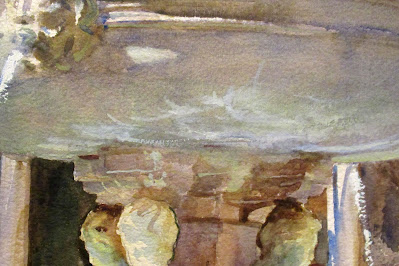"Since then, he worked energetically on all kinds of genres of ukiyo-e including “musha-e (warrior pictures)” of heroes, “giga (caricatures)”, landscapes, “bijin-ga (pictures of beautiful women)”, “yakusha-e (portraits of kabuki actors)”, and pictures for children."
Sunday, January 29, 2023
Cats Juggling Balls
Saturday, January 28, 2023
Botanical Art or Plein-Air Painting?
While both may result in attractive images of plants, the botanical artist is more concerned with portraying individual specimens with a scientist’s perspective, removing a plant from its context to understand the structure and exploring the beauty in that way.
The plein-air artist pays attention to the whole living ensemble as influenced by light, air, atmosphere, spatial depth. It’s possible to combine the two visual approaches—and the thought process behind them—to see both the forest and the trees.
Friday, January 27, 2023
Manu Forti
Thursday, January 26, 2023
Black Umbrellas
Wednesday, January 25, 2023
Alice in Larvaeland
No, it's not AI art—not digital either. I painted it for fun in acrylic during lunch break while I was a 22-year-old working as a background painter on the animated movie "Fire and Ice."
I suppose I was tapping into some weird corners of my subconscious mind, trying to figure out how to adapt H.R. Giger's biomorphism to landscape painting, and tossing some story possibilities out there for Ralph Bakshi's team to play with.
Monday, January 23, 2023
Shadow Letters
"On letters A, Y, V, W, M, the shade is narrower in width on the diagonal "letter strokes" that are affected by the shade at a forty-five degree angle.

"Where extremities of letters are close together, the stroke can be left disconnected, which liberty is legitimate and permissible, especially on card work.
"On the relief shade leave "relief space" quite wide—i. e., the space between the edge of letter and inner edge of shade; it gives the letter better emphasis and is more professional."
From A Show at Sho'-Cards by Atkinson
Sunday, January 22, 2023
Developing Neural Pathways
Learning to paint requires developing two different sets of neural pathways. One is the cognitive / perceptual skill of strategic observation, where you learn to see what you need to see at each stage of the process, no more, no less.
Much of this neural architecture takes place outside the cranial vault and requires that you develop new skills of hand/eye coordination, head movement, and even breathing.
Neuroscience News: The Link Between Drawing and Seeing in the Brain
Science Direct: Digest of Motor Learning Articles
Saturday, January 21, 2023
The Rhinecliff Hotel
Friday, January 20, 2023
The Death King Louis II of Hungary
Thursday, January 19, 2023
Head Study in Watercolor
Tuesday, January 17, 2023
Van Dyck's Study of Saint Jerome

"His goal was to convey the sense of the saint as a real person—one with whom faithful viewers could identify and whom they could aspire to emulate.” Quoted from Artnet,
The study will be auction later this month on January 26 at the Sotheby's auction of master paintings. Previews of the show will be in New York, January 21-25, 2023
Monday, January 16, 2023
Painting a Parking Lot
Today's post on Instagram about "non-motifs" seems to have struck a chord.
. Here are some of the responses:
ukesurfer
How do you take such a Mundane looking place and make it look really cool? I need to train my eye better to respect the spaces that are right there in front of me. You Did a lovely job. Thank you I will review those tips every time I go to paint.!
susypanozzoart
Fantastic. Love watching your videos. Thank you 🙏 😍
artofmiggy
I've been doing these 'boring scene' drawings for a while and am ALWAY shocked by how interesting they are in pen and ink... but of course, @jamesgurneyart takes it to eleven with his rock-solid ability. Gorgeous stuff.
sandramurphy7874
Your work always amazes me. You capture the beauty of the most mundane scenes. 😍😍
michael_jap
Thank you!
artonthecreek
Your underpaintings always sing, James. Bravo!
williamwingert
Excellent as always. And a great demo/reminder.
davidhouse.art
Love that Pentalic Field Book!👏👏
spacebandit_art
I need to watch this on YouTube and take notes!
lisaegelistudio
Well said !
jasonberlin
Beautiful 🙌🔥🙌👍🏼🎨💪
remingtonrobinson
I’ve been loving painting non-motifs for the past few years, especially because it suddenly makes everyday life much more interesting!
donnaleighrees
marybyromfineart
❤️❤️❤️❤️❤️! Right on!!!
kathrynhansenpencildrawings
Wow, great piece!! And tips!
raphaelegoineau
Suuuuuperbe cette lumière. Je dis un peu envieuse…😍
rcd.raw
Thanks for exist Mr James
snowboundartstudios
Question for you, I usually work in oils, they allowing me to blend colors. Between Gouache and Casein which is easier to blend?
jamesgurneyart
@snowboundartstudios The main difference in blending is that Gouache can be rewet and blended after it dries.
chrisfriendart
Incredible, I wouldn’t have given a parking lot a second glance if you asked me to pick a place to paint but of course you show it can be as good as any 👏
renitawellman
I’m always amazed by the cool compositions of Highway, cars, and curves in my rearview mirror.
jacobi_art
We need a video on how to paint backlit!
Saturday, January 14, 2023
What is a 'Non-Motif?'
1. Start out with an idea of the light, color or compositional effects you want to achieve, and plug the forms into that idea. For example, you might want to do a tight cropping on a colorful sign or you might want a warm, backlit scene with edge lighting.
2. Use a viewfinder, a mirror or a camera to give you a fresh eye on the scene. It’s often hard to recognize good subjects, even when you’re looking straight at them.
3. Do a thumbnail sketch in pencil or paint to visualize what choices you might need to make.
4. Try to key into an emotional reaction that you have about a place, something you love or hate about it, a juxtaposition that seems bizarre or somewhere that you enjoyed hanging out as a child.
5. Stay local. Paint the subject at different times of day, and if you can, different seasons of the year.
6. If you’re traveling, paint an ordinary street, not the Instagram spot.
Friday, January 13, 2023
Can We Really Know What Goes On in Our Brains?
Lars Ickenroth left a long and thoughtful comment after my last video, and I'll share it here, along with my response below:
"Probably the most important topic and video on painting. Question to Mr. Gurney: does language-based thinking versus visual thinking play a role in your processes? For me these are two identifiable modes when working: automatic (energetic) and analytic (rational). A lot of my process starts with this enthusiasm supported by a semi-automatic engine that has been cultivated over the years. But when there’s resistance - either from the mind not being focused or concrete visual problems that need solving - then I turn to asking active questions.
My answer: Lars, you've raised some powerful ideas, and I'm just trying to imagine what it would be like to be high up on scaffolding with a paint roller figuring out a painting. But you're absolutely right: there's a verbal part of my brain that mostly shuts off when I'm painting, and when I sketch next to my wife Jeanette, an hour can go by without a word. While I'm in the moment on location, my thought process often feels scrambled, like the undifferentiated bits of a caterpillar turning into a butterfly during metamorphosis. The voiceover that you hear on my videos is an attempt to rationalize and verbalize the process. But inevitably I hit a philosophical wall: How accurately can I or anyone really know what really goes on inside my mind? According to Dan Dennett in his famous Ted talk, the idea that we can accurately understand our own conscious processes is largely an illusion.
Wednesday, January 11, 2023
Stepan Kolesnikoff's Gouache Landscapes
, sometimes rather small.
Tuesday, January 10, 2023
Simplification vs. Elaboration
"The more one knows the more one simplifies," said Alfred Stevens, and the same thought was expressed by William M. Hunt, when he said, "Elaboration is not beauty and sandpaper never finished a bad piece of
work."
Monday, January 9, 2023
Winston Churchill's Ideas About Painting

"This beginning with Audacity, or being thrown into the middle of it, is already a very great part of the art of painting."

"Painting a picture is like trying to fight a battle."
"Painting is the same kind of problem as unfolding a long, sustained interlocked argument... It is a proposition commanded by a single unity of conception."
“Go out into the sunlight and be happy with what you see.

“We cannot aspire to masterpieces. We may content ourselves with a joy ride in a paint-box. And for this Audacity is the only ticket.”
He was timid about painting until he saw a friend begin to “hurl slashes of paint on an absolutely cowering canvas. Anyone could see that it could not hit back.”
Sunday, January 8, 2023
Painting in the Winter Forest
As I paint it, I talk about brushes and paints, and also share my thoughts about:
2. Winston Churchill's philosophy of painting
3. And a more Taoist view of the painting mindset.
Saturday, January 7, 2023
Video Release Tomorrow
Friday, January 6, 2023
Painting People in Rural France
Ohio-born artist Elizabeth Nourse painted directly from models in rural France. She was often "in villages with no inns or accommodations and lived either with members of a religious community or with the peasants, to an innate sympathy with women and children of the peasantry and enabled her to gain their confidence and observe them closely while living among them."
"Cecilia Beaux (1855-1942) had quite a different experience in Brittany. Writing about her unsuccessful efforts to get a Breton woman to pose for her, she observed, 'We found that the people, especially the country folk, did not really like les artistes.'"
Quotes from Elisabeth Nourse, 1859-1938, A Salon Career
Source: Wikipedia on Elizabeth Nourse and Cecilia Beaux
Wednesday, January 4, 2023
Dino vs. Robot Battle
Tuesday, January 3, 2023
Monday, January 2, 2023
Pío Collivadino
Pío Collivadino (1869-1945) was an Argentinian artist who studied in Italy.


